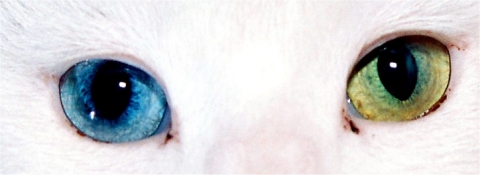Odd-eyed cats

Some cats have green eyes, others have amber, some have blue. However, in rare cases we get cats that have eyes of one colour each. These are called 'odd-eyed cats'. How do they get that way, and how common is it?
The technical name for this condition is Heterochromia Iridis. This sounds more scientific than 'odd-eyed' but is basically Greek for 'differently coloured irises', and so means pretty much the same thing. Heterochromia iridis is not a medical condition, and an odd-eyed cat certainly does not suffer any disadvantage from being so.
There are two types of heterochromia:
- Partial or sectoral heterochromia is when one iris has more than one colour
- Complete heterochromia is when the iris of one eye has a different colour to the other.
Humans can have heterochromia as well as cats, though complete heterochromia in humans is very rare. While cats with complete heterochromia are called 'odd-eyed cats', humans with partial heterochromia are said to have 'cat's eyes'.
What causes heterochromia?
With humans and cats, the colour of the eye is determined by the amount of a pigment known as menalin - the same pigment that turns pale-skinned people brown when they get a suntan. The amount of pigment in the iris is usually determined by an individual's genetic make-up (though in rare cases this can also be affected by injury).
Some cats have the white or white-spotted gene and this is the usual cause of heterochromia. This gene affects coat colour as a dominant white gene (W) masks any other colour genes to make a completely white cat. The white spotted gene (S) is responsible for bi-colour and tuxedo cats.
While a kitten's coat develops its colour in the womb, all kittens are born with blue eyes. As the kitten develops, melanin granules move into the iris, and between seven and twelve weeks the eyes change to the colour that they will then remain. If no melanin moves in, the cat will remain blue-eyed. However, a side-effect of the S gene prevents melanin from reaching just one eye as the kitten grows. Therefore this eye will always be blue. The other eye will change colour to either green, brown or yellow. Looking into the eyes of a newborn kitten, a keen observer might detect the slightly different shades of blue which mark a future odd-eyed cat.
Some cat breeds, for example the Turkish Van, Turkish Angora and Japanese Bobtail are more likely to develop complete heterochromia, although any cat which has the S or W gene can become an odd-eyed cat. It is very rare that cats without one of those two genes develop heterochromia iridis. Complete heterochromia is rare, and because of this Turkish Angora cats with blue and amber eyes are considered a national treasure in Turkey. Indeed, since 1917, the government of Turkey has been working with the Ankara Zoo in a meticulous breeding program to protect and preserve the pure white, odd-eyed Turkish Angora.
Partial heterochromia is caused by varying concentrations of melanin in a single iris. Since the amount of melanin in an iris determines its colour, an iris with different concentrations of melanin will be more than one colour. The most common partial heterochromia (and the related so-called 'central cheterochromia') is when the inside of the iris is darker than the outside.
If a mature cat develops heterochromia, this is cause for concern. If an iris grows darker, this type of heterochromia may well be due to an accumulation of iron deposits or blood in the anterior chamber of the eye. This may be caused by inflammation of the eye. Low grade uviatis may cause the opposite effect and make an eye appear lighter, with washed-out colours. If you notice that your cat's eye or eyes have suddenly changed colour it is worth consulting the vet.
